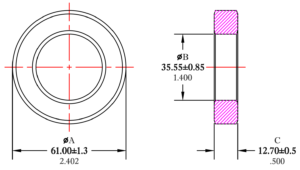My nanoVNA-H v3.3 is just over six months old. It has succumbed to most of the common hardware faults and some of the less common ones, but until now the touch screen has worked ok.
That has changed, the bezel bears on the touch screen and causes input when the case is held even very lightly by the edges… sufficiently so that it was unusable.
A perhaps temporary resolution was to place four 1mm thick M2 5mm OD nylon washers on the front part of the case before carefully placing the PCB assembly on top, then the case back and screws. This is a bit tedious if one of the washers moves, next time it is apart to fix hardware issues, I might put a dot of CA adhesive under each washer.
The case design is inadequate, it needed some features incorporated into the molding of the front to space the edges of the bezel off the PCB so that it maintained the requisite spacing even when held, even after the molding changes over time (perhaps normalisation of stresses from the molding process).



